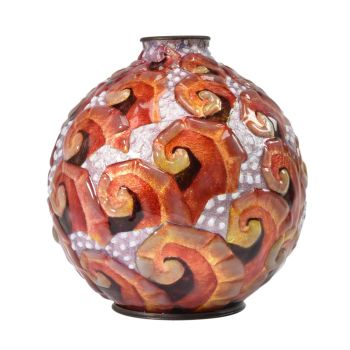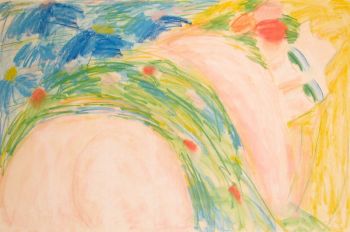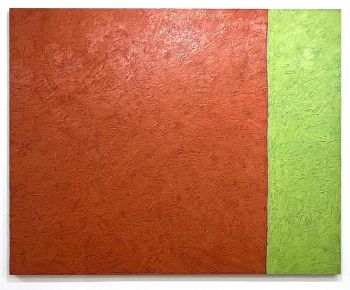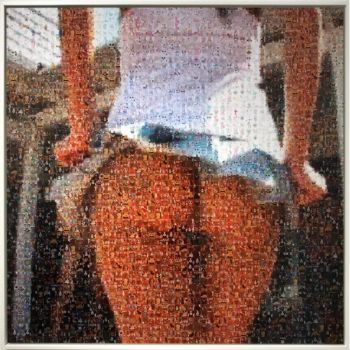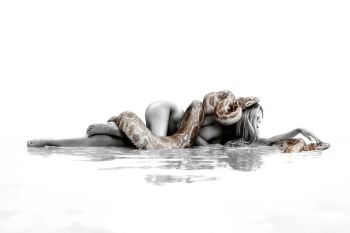Jan Sluijters was more than just a 'painter of nude women'
Jan Sluijters was mainly known to the general public as a 'painter of women'. He said about his nude models: 'If I have painted them, I don't want them anymore and if I want them, I can't paint them anymore'. He was concerned with the psyche of women but only of beautiful women. Anyone who has an extensive overview of Sluijters' work can't deny that the painter was capable of much more. In this article we give a description of his life and we try to show his development as a painter with examples of several of his works. At the end of this article we indicate where you can admire the artworks of Jan Sluiters and also where you can buy original paintings and drawings by Jan Sluiters.
The early years of Jan Sluijters
Jan Sluijters was born in 1881 and grew up in a simple Roman Catholic family. Artistry was spoon-fed to him at an early age. His father was a wood engraver and made illustrations for advertising posters and various catalogues. Jan's aptitude for drawing and painting became apparent early on, and he was mainly stimulated by his father.
When he was fourteen years old, he moved with his parents and his three sisters from his birthplace 's-Hertogenbosch to Amsterdam. In this city he would eventually spend most of his life.
 A still relatively young Jan Sluijters posing as a painter
A still relatively young Jan Sluijters posing as a painter
Jan Sluijter becomes an independent artist
In Amsterdam, Sluijters attended the HBS school and then, from 1898 to 1901, the State Normal School for Drawing Education. He soon received his first independent illustration assignments, including for the Illustrated Police News. There he illustrated the weekly chronicle of extraordinary occurrences and made illustrations of crimes and accidents. During this period, the still young Jan Sluijters also illustrated for various children's books.
He received his diploma in July 1901. And subsequently, for one course year – from October 1901 to July 1902 – he was part of the small painting class led by professor Nicolaas van der Waay at the State Academy of Art. The following year he also attended the evening course in the drawing class led by Prof. August Allebé.
In 1904 Jan Sluijters won the prestigious Prix de Rome with the canvas 'The prophet Elisha and the son of the Shunammite woman', painted 'in an academic style'.
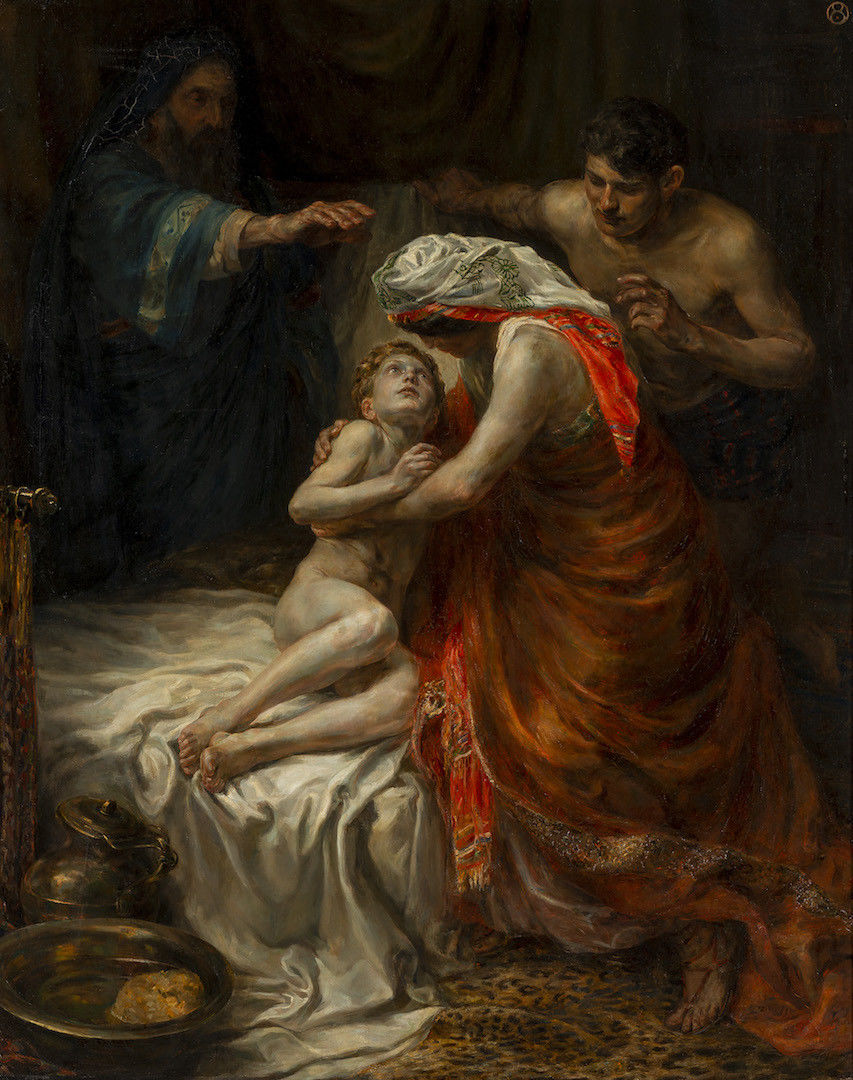 Jan Sluijters, The Prophet Elisha and the Son of the Shunammite Woman, 1904, oil on canvas
Jan Sluijters, The Prophet Elisha and the Son of the Shunammite Woman, 1904, oil on canvas
Jan Sluijters wild years
Rewarded with a scholarship, he was able to study the art of the classics for four years. His drawn and painted impressions of a tour he, newly married, made in 1905 and 1906 together with his wife Bertha Langerhorst through Italy and Spain, were initially approved by the jury of the Prix. But that certainly did not apply to the work made in Paris, in which, according to the jury report, he renounced the academic ideal by 'celebrating the false ingenuity of the latest French trend'.
His stay in Paris in 1906 was important to Sluijters. He was captivated by the work of the Neo-Impressionists and Fauvists and that of artists such as Henri de Toulouse-Lautrec and Kees van Dongen. He absorbed the achievements of these painters like a sponge. Using loose brushstrokes and bright colours, Sluijters dynamically captured Parisian street and café life in works such as Café Olympia, Femmes qui s'embrassant and Bal Tabarin. However, these paintings were considered too frivolous and too daring by a large part of the Dutch public. It ultimately cost him his scholarship, but unintentionally earned him a lot of publicity in the Netherlands. Back in Amsterdam in November 1906, he had already made a name for himself as a pioneer of Dutch modernism.
 Jan Sluijters' Wild Years, Bal Tabarin, 1907
Jan Sluijters' Wild Years, Bal Tabarin, 1907
Jan Sluijters' luministic landscapes and cityscapes
The fierce reactions of the conservative critics, his paintings were often refused at exhibitions, did not make Sluijters stop his urge to innovate. On the contrary, he continued to experiment with all sorts of new, modernist forms of expression and processed these into an often own, recognizable painting style.
Certainly in the beginning he chose the surroundings of his hometown Amsterdam as a subject for painting. Numerous luministic landscapes and cityscapes date from 1907 and 1908, composed of broad dots and strokes of bright, unmixed colors. In these works the emphasis was always on the representation of the sensation of light, in which the free, expressive touches of color determine the structure of the canvas. Luminism reached a peak in the paintings that were created in 1909 in Heeze in Brabant and especially from 1910 in Laren.
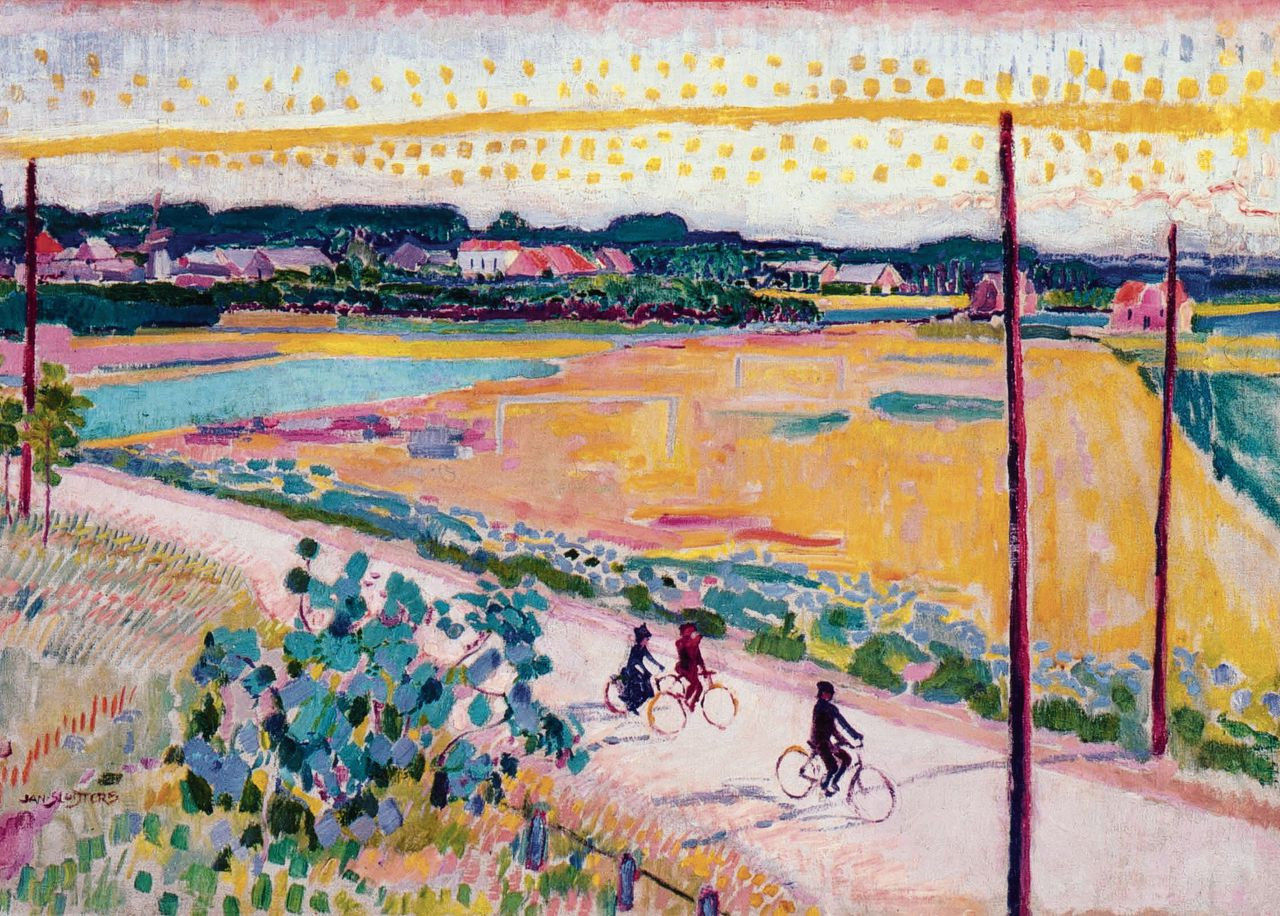 Jan Sluijters, Laren landscape with cyclists, 1911
Jan Sluijters, Laren landscape with cyclists, 1911
His Gooische period and the influence of Van Gogh
In March 1910 Sluijters divorced Bertha Langerhorst. Together with his new lover, Greet van Cooten, whom he had met in early 1909, he lived in the Gooi for extended periods until the spring of 1911. Inspired by the late work of Vincent van Gogh, he painted his famous October suns and moon nights, themes on which he varied endlessly.
The loose, as if by chance placed brushstrokes, were replaced by larger, interlocking areas of color and flowing contours, which made his work gain in clarity and expressiveness. The intensity of the color was increased in portraits and figure pieces, for which Greet often served as a model, such as Reading Woman from 1911.
 'Reading woman' (Greet van Cooten), 1911, Jan Sluijters
'Reading woman' (Greet van Cooten), 1911, Jan Sluijters
In his desire for change, Sluijters found connections with other foremen of the modern direction in painting, including Piet Mondriaan and Leo Gestel. They influenced each other and founded the Moderne Kunstkring together with Conrad Kickert, Jan Toorop and Cees Spoor in the autumn of 1910. This circle was mainly founded to show the work of the foreign avant-garde in the Netherlands and was the answer to more traditionally oriented artists' associations, such as 'Arti et Amicitiae'.
Although Sluijters defended the modern cause with verve in these years - 'a serious action is needed', he wrote to Cees Spoor (letter 7-7-1910) - he was by no means a theorist or a champion of any current. In his attempt to develop a personal style, he drew not from theoretical considerations, but for the sake of expression – from various avant-garde art movements, such as Fauvism, Cubism, Futurism and Expressionism. Because of the ease with which he used elements from these movements, he would later be accused of a certain 'stylelessness'.
 Jan Sluijters, ‘Oktoberzon - Laren’, 1910
Jan Sluijters, ‘Oktoberzon - Laren’, 1910
Sluijters never opted for a radical solution – in that sense he distinguished himself from Piet Mondriaan – and kept the perceived reality as the starting point. On the basis of this attitude, he was not only able to produce 'ultramodern' works in the same period, such as 'The awakening' from 1913 and the almost abstract Portrait of a Lady in a Riding Suit from 1914, but also to make realistic, mercilessly characterizing portraits like those of the collector. Piet Boendermaker and van Jordaan women.
A comparable realism was expressed in the strongly narrative political prints he made during the First World War for De Nieuwe Amsterdammer. He was not concerned with expressing political commitment. Rather, he used the opportunity to depict the dramatic topicality of the war in an expressive visual language.
 Jan Sluijters, in Cubist style 'Lady in riding suit', 1914
Jan Sluijters, in Cubist style 'Lady in riding suit', 1914
Jan Sluijters' Staphorst period
In the summer of 1915, Sluijters stayed in Staphorst for a month. The works he made as a result of this visit form a closed whole within his oeuvre. Without any sentiment, he recorded the farming village and its population in a series of studies and variations of portraits and landscapes, which eventually found a connection in the monumental canvas Staphorster farmer's family. Striking is the use of dark colors and the increasing schematization of the form. The latter aspect was continued in the stylized dancers and nudes, which appeared shortly afterwards in paintings, but also on posters and on the covers of the monthly magazine Wendingen in 1918/1919.
 Jan Sluijters, Staphorster family, 1915/16 (for sale via Gallerease)
Jan Sluijters, Staphorster family, 1915/16 (for sale via Gallerease)
Jan Sluiters' domestic period
Symbolic for a later and completely new phase in the development of Sluijters' oeuvre is 'The painter's family', a large canvas from 1922. Like many other artists in the 1920s, Sluijters made a 'retour à l'ordre': a return to a moderately classical, figurative style. He chose his subjects from his immediate surroundings and painted, in addition to portraits, nudes and still lifes, various interiors in which his wife and children play a role.
As he got older, Sluijters led more and more of a domestic life and kept a strict daily schedule: 'I work all day and in the afternoon I go to Arti, play billiards. I am a real grocer among my colleagues, not at all artistic' (De Groene Amsterdammer , 26-5-1928). Apart from holidays and a few visits abroad, his radius of action was limited to Amsterdam. He lived there for years in the Lomanstraat and from 1930 on the Olympiaplein: 'The whole world for my inspiration lies in a circle of twenty-five meters around this. I don't travel. Here I find everything I paint, my wife, my children, this furniture, a few vases and mugs – the flowers, yes, these cactus plants, and now and then a model' (Nieuwe Rotterdamsche Courant , 24- 12-1927).
 'Jan, Rob and Liesje Sluijter', Jan Sluijters, 1926-1928 (original painting for sale via Gallerease)
'Jan, Rob and Liesje Sluijter', Jan Sluijters, 1926-1928 (original painting for sale via Gallerease)
Appreciation for Sluijters' work grew steadily. He was now an established artist, who had risen above criticism and was regularly honored with retrospective exhibitions at Amsterdam's Stedelijk Museum, the first of which was in 1927. As an authority on the visual arts, he was asked to serve on numerous juries and committees. A nice anecdote is that he, as a 'former woman painter', was invited in 1929 to be a jury member at the first Miss Holland election.
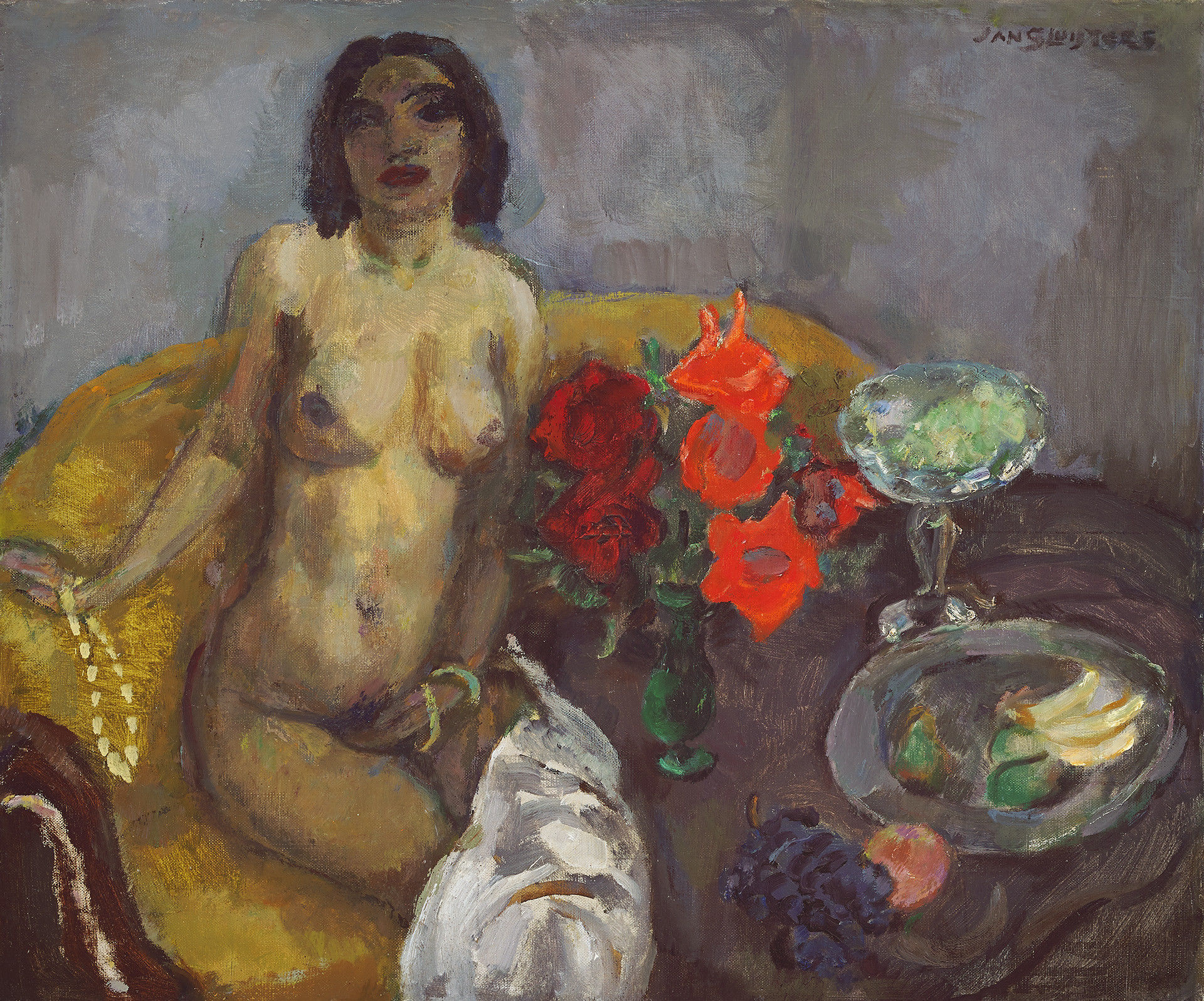 Jan Sluijters, Mulattin on sofa, 1927 (for sale via Gallerease)
Jan Sluijters, Mulattin on sofa, 1927 (for sale via Gallerease)
Jan Sluijters as portrait painter
Around 1930, Sluijters was regarded as the portrait painter of the Netherlands. He painted numerous prominent compatriots on commission from university circles, the music and theater world and the business community. These portraits vary from sober, somewhat distant images to penetrating character sketches, such as that of the Amsterdam alderman F.M. Wibaut and the conductor Willem Mengelberg.
In the course of the thirties, Sluijters' palette darkened. He thus followed a general tendency within painting, but remained primarily a colourist, who managed to suggest the intended form not so much with lines as with variations of greys, greens and browns.
 Jan Sluijters' character sketch of Alderman Wibaut, 1933
Jan Sluijters' character sketch of Alderman Wibaut, 1933
Jan Sluijters during the Second World War
During the German occupation, Sluijters became depressed and was admitted to the Amsterdam Valerius clinic for some time. He suffered from the fact that as a result of the war, a very prosperous period in his career had suddenly come to a halt, while also limiting his social life. A combination of psychological and physical factors – including a severe form of anemia – meant that he hardly got around to painting. He remained a member of 'Arti et Amicitiae' and therefore automatically became a member of the Kultuurkamer, which put him under a six-month ban on exhibitions after the liberation. He resignedly accepted this and soon found his old zest again.
Renewed appreciation for Jan Sluijters
In a colorful and decorative style, he painted portraits of his grandchildren and cheerful interior pieces, including La joie de peindre from 1946 and Motherhood from 1948. Sluijters continued to be regarded as the 'grand old man' of Dutch painting, who nevertheless took a positive view of the youngest avant-garde, the Cobra movement. When he was diagnosed with lung cancer in 1956, he became depressed again. He died the following spring and was buried under great interest from the Stedelijk Museum in Amsterdam.
 Jan Sluijters, 'At the Couturier', 1930-1953, (available for sale via Gallerease)
Jan Sluijters, 'At the Couturier', 1930-1953, (available for sale via Gallerease)
Jan Sluijters may be regarded as one of the fundamental innovators of Dutch painting in the twentieth century, although this appreciation mainly applies to his work from the period around 1910. For half a century he played an active role in art life and, on the contrary, he represented that group of artists who considered painting 'pur sang' of paramount importance.
He was often characterized as a fiery painter's animal, but in reality he was a searching and hardworking painter, who tried things over and over again, but also repeatedly picked up the same themes in his paintings, sometimes in barely modified form. His virtuoso talent, his versatility and passion for work were reflected in an impressive oeuvre that, in addition to numerous watercolors, drawings, book illustrations, political prints and posters, comprises an estimated three thousand works in oil paint.
 Jan Sluijters , 'Interior with two women and a dog, 1931
Jan Sluijters , 'Interior with two women and a dog, 1931
Jan Sluijters started his painting career as a headstrong rebel, who shocked the community and eventually he ended up as the universally acclaimed master, the favorite of the establishment and he still has that reputation.
Where can you view original works by Jan Sluiters?
The museums where you can visit Jan Sluijter's works include: the Noordbrabants Museum in Den Bosch, the Boijmans Van Beuningen Museum in Rotterdam, the Singer Museum in Laren, the Kröller-Müller Museum in Otterlo, the Art Museum The Hague, the Stedelijk Museum in Amsterdam and the Central Museum Utrecht.
Where can you buy original works by Jan Sluijters?
Through Gallerease we offer a large collection of works by Jan Sluijters for sale. Via this link you can orientate yourself on the available works of Jan Sluijters.























